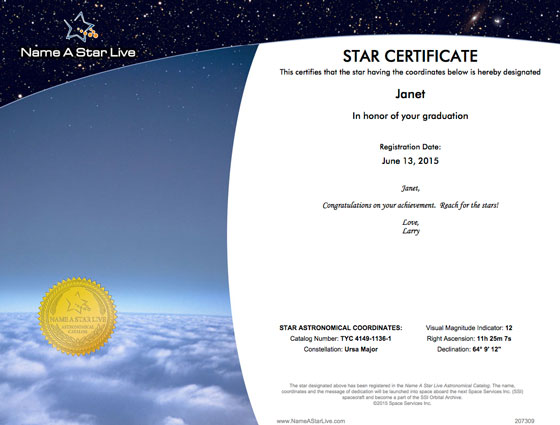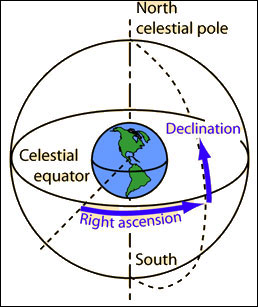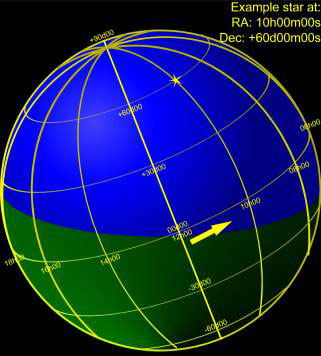
All Name A Star Live gift sets include a letter-size Star Certificate that displays the name of your star, what the star is named in honor of (such as a graduation, an anniversary, love, Christmas, Valentine’s Day), the star’s registration date, a personal message you write for your gift recipient, and the astronomical coordinates of your star.
The star on the Star Certificate above is named “Janet” in honor of her graduation, and the star’s registration date is June 13, 2015. But what does all that astronomical gobbledygook toward the bottom of Janet’s Star Certificate really mean?
Let’s take a closer look at the “STAR ASTRONOMICAL COORDINATES”:

TYC 4149-1136-1 is this particular star’s “Catalog Number” in the “Tycho 2” star catalog. A star catalog is just a list of stars, and there are many such lists. The Tycho 2 star catalog is widely used in astronomy and commonly used in advanced astronomy software.
The “Constellation” is the area of the night sky in which your star is located. Constellations are like the states of the U.S. or the provinces of Canada, only they define specific parts of the night sky rather than specific parts of a nation. Examples of constellations include Aries, Taurus, Sagittarius and Ursa Major (where the Big Dipper is located).
The “Visual Magnitude Indicator” is what is known in astronomy as the star’s “apparent magnitude” — how bright the star appears to us when we observe it from Earth. This star has an apparent magnitude of 12. Most astronomers would say this star is a “12th magnitude star,” a “magnitude 12 star” or simply a “mag 12” star. The higher the mag number, the dimmer the star is. So a mag 3 star is dimmer than a mag 2 star, which in turn is dimmer than a mag 1 star. Very bright astronomical objects, like the Sun, have negative magnitude values.

The Sun has an apparent magnitude of -26.7. The full Moon is mag -12.6. At its brightest, the planet Venus (a.k.a. the “morning star” or the “evening star”) is mag -4.4. In brightly lit areas of large cities, probably about the dimmest star you can see is a mag 1 or maybe a mag 2 star. In the suburbs you might see as dim as a mag 4 star. Under perfect viewing conditions — far away from city lights (e.g., out at sea, or in the middle of a desert), no moonlight, you have 20/20 vision, etc. — you could just barely make out a mag 6 star. For our customers we normally assign stars of mag 10 or greater, which means a telescope is needed to view them.
The “Right Ascension” and “Declination” are what astronomers refer to as the star’s astronomical coordinates. Right Ascension (RA) corresponds to longitude on Earth and Declination (Dec) corresponds to latitude on Earth.

For purposes of identifying the precise position of a star, astronomers think of the universe as a giant sphere — called the “Celestial Sphere” — where we are in the exact center of the sphere. To put it another way, think of the universe as a huge beach ball and Earth as a baseball smack dab in the center of the beach ball. So when we look at the stars at night, it’s as if we are standing on the baseball looking up at the inside of the beach ball. Just as circular lines of latitude and longitude can be used to identify a precise location on Earth, circular lines of Dec and RA can be used to identify a precise location in the night sky.
RA is measured in “hours,” which is somewhat confusing at first glance since we measure time in hours. The values of RA run from 0 hours to 24 hours. Specific RA values on Name A Star Live Star Certificates are listed in hours, minutes and seconds.
Dec is measured in degrees, and ranges in value between -90 degrees to +90 degrees. Specific Dec values are listed in degrees, minutes and seconds. If your star has a positive Dec value, that means it lies in the northern half of the Celestial Sphere — the top part of the beach ball. If your star has a negative Dec value, then your star is located in the southern half of the Celestial Sphere. Note that Right Ascension never has a negative value.

An astronomer can use the RA and Dec values from your Star Certificate to locate your star in the night sky. If the astronomer’s telescope is guided by a computer, it’s usually quicker and easier for the astronomer to input the star’s catalog number into the computer rather than the RA and Dec values.
—
Name A Star Live makes the otherwise symbolic gesture of star-naming real not only by launching your star’s name into space, but also by providing you the precise coordinates and catalog number for your star. Happy stargazing!